Chaney Instrument 00634TX Weather Station transmitter User Manual 00634 INST09 WA
Chaney Instrument Co. Weather Station transmitter 00634 INST09 WA
manual
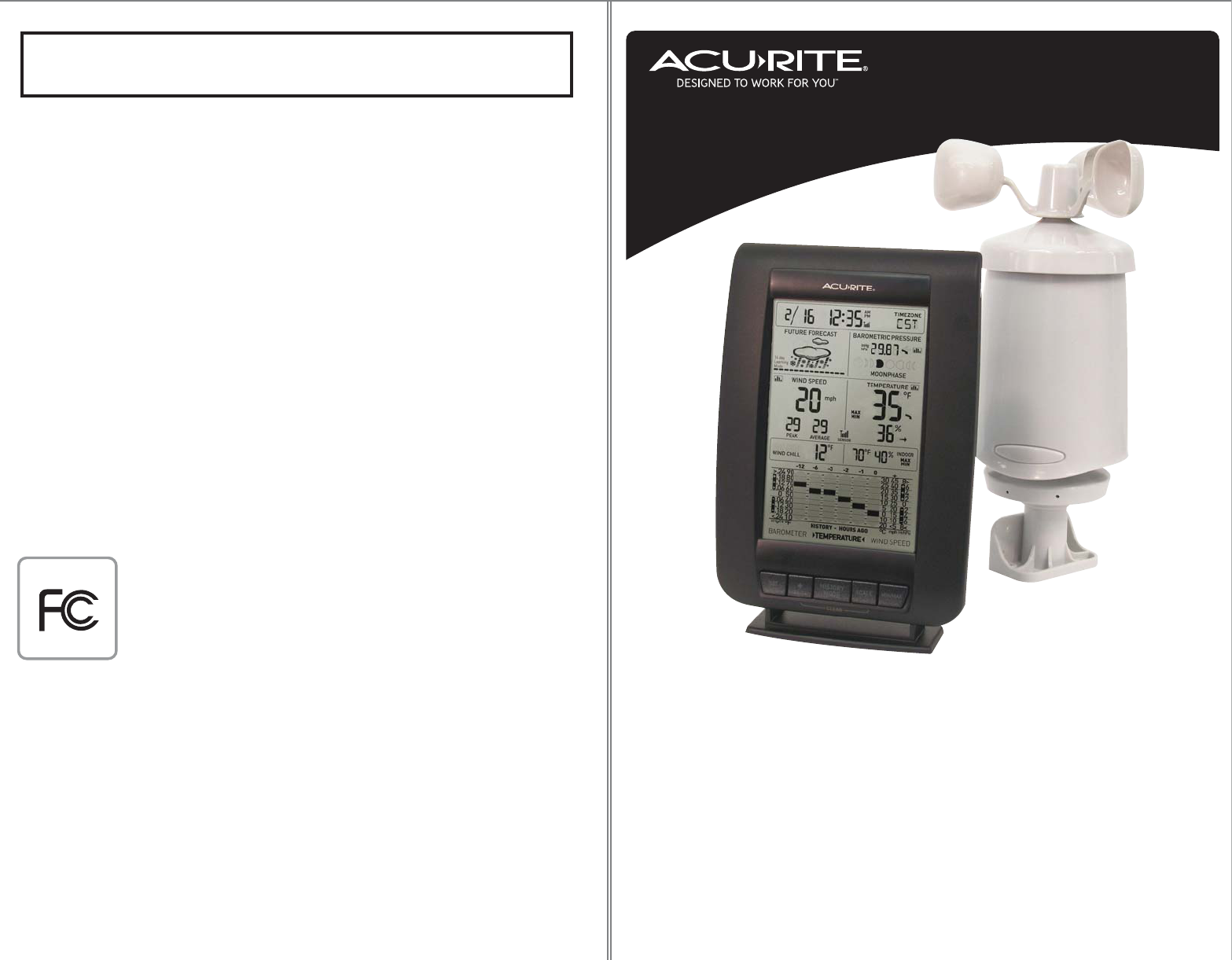
Wireless Weather Station
model #00634
Instruction Manual
Package Contents:
(1) Main Unit (A) with stand
(1) Wireless Sensor (B) with
mounting bracket
What You Need:
• Small Phillips Screwdriver
• (7) AA batteries
A. Main Unit
B. Wireless Sensor
INST - 00634 081309
Thank You for purchasing this ACURITE® product. Please read this manual in it’s entirety
to fully enjoy the benets and features of this product. Please keep this manual for
future reference.
NOTE: A clear lm is applied to the LCD at the factory that must be removed prior to
using this product. Locate the clear tab and simply peel to remove.
LIMITED ONE YEAR WARRANTY
Chaney Instrument Company warrants that all products it manufactures to be of good material and workmanship and to be free of defects
if properly installed and operated for a period of one year from date of purchase. REMEDY FOR BREACH OF THIS WARRANTY IS EXPRESSLY
LIMITED TO REPAIR OR REPLACEMENT OF DEFECTIVE ITEMS. Any product which, under normal use and service, is proven to breach the
warranty contained herein within ONE YEAR from date of sale will, upon examination by Chaney, and at its sole option, be repaired or
replaced by Chaney. In all cases, transportation costs and charges for returned goods shall be paid for by the purchaser. Chaney hereby
disclaims all responsibility for such transportation costs and charges. This warranty will not be breached, and Chaney will give no credit for
products it manufactures which shall have received normal wear and tear, been damaged, tampered, abused, improperly installed,
damaged in shipping, or repaired or altered by others than authorized representatives of Chaney.
THE ABOVE-DESCRIBED WARRANTY IS EXPRESSLY IN LIEU OF ALL OTHER WARRANTIES, EXPRESS OR IMPLIED, AND ALL OTHER WARRANTIES
ARE HEREBY EXPRESSLY DISCLAIMED, INCLUDING WITHOUT LIMITATION THE IMPLIED WARRANTY OF MERCHANTABILITY AND THE IMPLIED
WARRANTY OF FITNESS FOR A PARTICULAR PURPOSE. CHANEY EXPRESSLY DISCLAIMS ALL LIABILITY FOR SPECIAL, CONSEQUENTIAL OR
INCIDENTAL DAMAGES, WHETHER ARISING IN TORT OR BY CONTRACT FROM ANY BREACH OF THIS WARRANTY. SOME STATES DO NOT
ALLOW THE EXCLUSION OR LIMITATION OF INCIDENTAL OR CONSEQUENTIAL DAMAGES, SO THE ABOVE LIMITATION OR EXCLUSION MAY
NOT APPLY TO YOU. CHANEY FURTHER DISCLAIMS ALL LIABILITY FROM PERSONAL INJURY RELATING TO ITS PRODUCTS TO THE EXTENT
PERMITTED BY LAW. BY ACCEPTANCE OF ANY OF CHANEY’S EQUIPMENT OR PRODUCTS, THE PURCHASER ASSUMES ALL LIABILITY FOR THE
CONSEQUENCES ARISING FROM THEIR USE OR MISUSE. NO PERSON, FIRM OR CORPORATION IS AUTHORIZED TO ASSUME FOR CHANEY
ANY OTHER LIABILITY IN CONNECTION WITH THE SALE OF ITS PRODUCTS. FURTHERMORE, NO PERSON, FIRM OR CORPORATION IS
AUTHORIZED TO MODIFY OR WAIVE THE TERMS OF THIS PARAGRAPH, AND THE PRECEDING PARAGRAPH, UNLESS DONE IN WRITING AND
SIGNED BY A DULY AUTHORIZED AGENT OF CHANEY. THIS WARRANTY GIVES YOU SPECIFIC LEGAL RIGHTS, AND YOU MAY ALSO HAVE
OTHER RIGHTS WHICH VARY FROM STATE TO STATE.
For in-warranty repair, please contact:
Customer Care Department
Chaney Instrument Company
965 Wells Street
Lake Geneva, WI 53147
Chaney Customer Care 877-221-1252
Mon-Fri 8:00 a.m. to 4:45 p.m. CST
www.chaneyinstrument.com
This device complies with part 15 of the FCC rules. Operation is
subject to the following two conditions:
1- This device may NOT cause harmful interference, and
2- This device must accept any interference received, including
interference that may cause undesired operation.
NOTE: This equipment has been tested and found to comply with the limits for a Class B
digital device, pursuant to Part 15 of the FCC rules. These limits are designed to provide
reasonable protection against harmful interference in a residential installation. This equipment generates,
uses and can radiate radio frequency energy and, if not installed and used in accordance with the instruc-
tions, may cause harmful interference to radio communications. However, There is no guarantee that
interference will not occur in a particular installation. If this equipment does cause harmful interference to
radio or television reception, which can be determined by turning the equipment o and on, the user is
encouraged to try to correct the interference by one or more of the following measures:
• Reorient or relocate the receiving antenna.
• Increase the separation between the equipment and the receiver.
• Connect the equipment into an outlet on a circuit dierent from that to which the
receiver is connected.
• Consult the dealer or an experienced radio/TV technician for help.
NOTE: The manufacturer is not responsible for any radio or TV interference caused by unauthorized modica-
tions to this equipment. Such modications could void the user authority to operate the equipment.
Patent numbers: 5,978,738; 6,076,044; 6,597,990
- 1 -
To receive product information, register your product online. It’s quick and easy!
Log on to http://www.chaneyinstrument.com/product_reg.htm

SECTION 2 • SETUP
Battery Choice & Temperature Range
- 3 -- 2 -
A clock is considered atomic if it has an accuracy of one second in a million years.
Consumer clocks are considered atomic if they attain this accuracy by receiving a
signal from an atomic clock. In North America, the National Institute of Standards and
Technologies operates an atomic clock in Colorado which transmits the time codes
via the radio station WWVB. The Acurite clock you have purchased includes a built-in
receiver which picks up the signal from the WWVB station. For the best possible
reception, place the main unit with the back side facing Colorado. NOTE: Due to solar
radiation in the atmosphere, the atomic clock signal is weaker during the day. Most
synchronization with the WWVB atomic clock signal happens at night when there is
less interference.
About the Atomic Clock
This wireless weather station features a wireless sensor that provides wind,
temperature and humidity data and broadcasts this information to the main display
unit. This wireless sensor will provide accurate outdoor weather conditions when
placed properly. The wireless sensor contains sensitive electronic components and a
balanced anemometer (for wind speed measurement). Care must be taken during
setup and when considering placement to make certain the unit is not dropped or
struck with any falling debris from trees or structures.
About the Wireless Sensor
Extended periods of cold temperatures ( below -4ºF / -20ºC ) can cause alkaline
batteries to function improperly. This will cause the outdoor wireless sensor to stop
transmitting temperature readings. Use lithium batteries in these low temperature
conditions to ensure continued operation for wireless sensors placed outdoors. NOTE:
Rechargeable batteries are not recommended due to higher operating voltages.
40
To allow for more than one weather station and wireless sensor network to be
used in close proximity, the main unit and the wireless sensor have a small
switch labeled “A B C” within the battery compartments. This switch selects one
of 3 wireless modes to use, and both switches MUST be set in matching
positions (either A, B, or C) for wireless communication to take place
successfully.
A/B/C Wireless Selection
SECTION 1 • OVERVIEW OF FEATURES
Setup and Operation
Buttons
Tabletop Placement
Display Stand
HISTORY GRAPH:
last 12 hours of
Barometer,
Outdoor Temperature,
Wind Speed
(user selectable)
SEASONAL
INFORMATION:
Heat Index,
Dew Point,
Wind Chill
(automatic)
WIND SPEED:
Current wind speed,
Peak wind speed,
Average wind speed
FUTURE FORECAST:
Self calibrating
weather forecast
ATOMIC CLOCK:
Automatically maintains
accuracy and resets for
daylight saving time
INDOOR CONDITIONS:
Temperature & Humidity
OUTDOOR CONDITIONS:
Temperature & Humidity
with Trend Indicators
Moonphase
BAROMETRIC PRESSURE:
Current value with trend
indicator
WIRELESS SENSOR:
Wireless reception indicator
ATOMIC CLOCK:
Atomic clock signal
reception indicator
WIRELESS SENSOR:
Low Battery indicator
ANEMOMETER:
Provides wind speed,
wind speed peak and
wind speed average
SOLAR-WEATHER SHIELD:
Provides some protection
from solar radiation
aecting temperature
readings and prevents
precipitation from entering
into the instrumentation pod.
SURFACE MOUNT BRACKET
INSTRUMENTATION POD:
Houses the sensitive
instrumentation and the
wireless 433 MHz transmitter
that provides weather
information to the main
display unit.
BATTERY COMPARTMENT
MOUNTING POINT:
The wireless sensor can be
mounted onto a pipe
(pipe not included) or
onto the included surface
mount bracket
MAIN UNIT
WIRELESS SENSOR
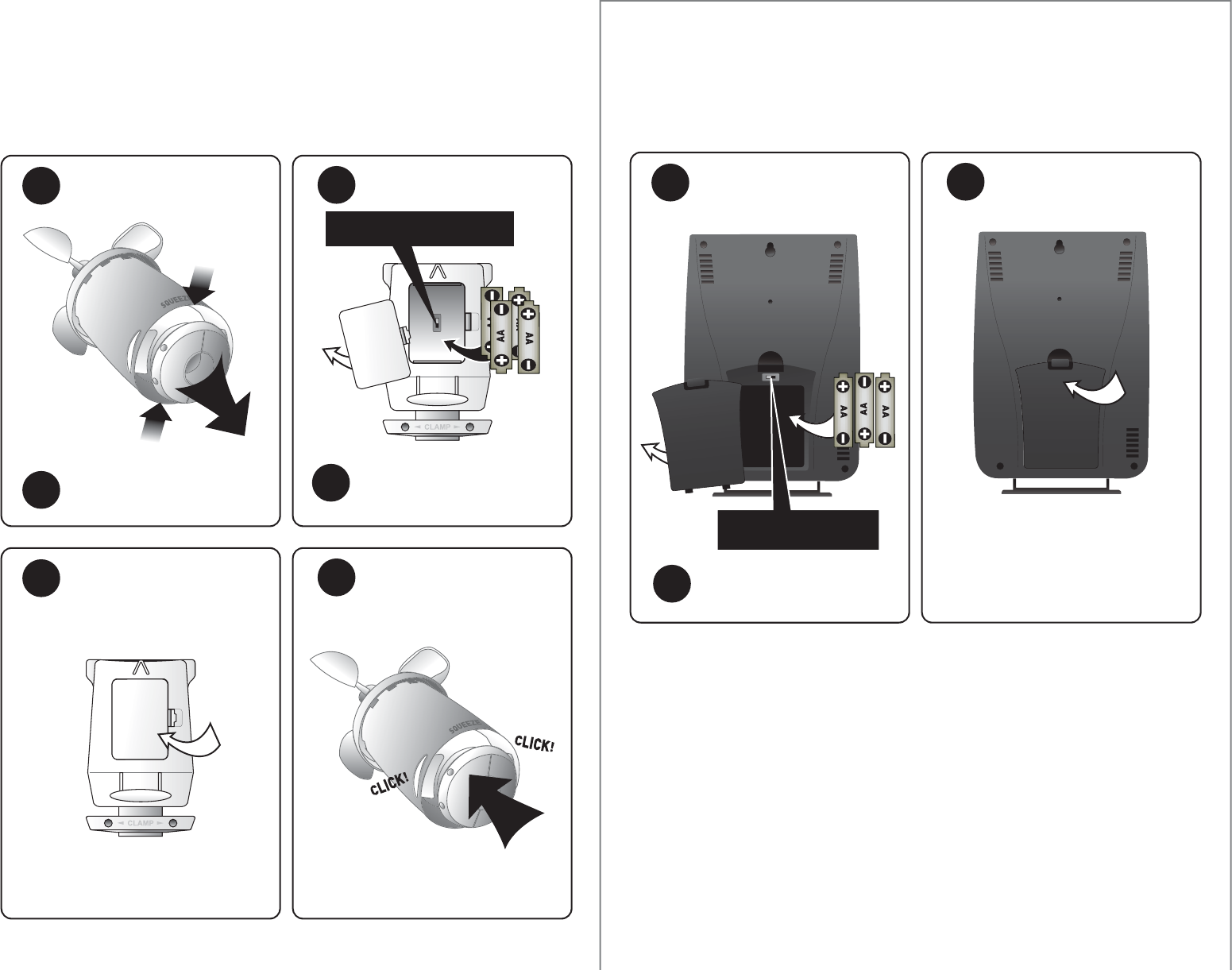
- 5 -- 4 -
Install Batteries
Wireless Sensor - 4 “AA” Batteries Required (not included) Main Unit - 3 “AA” Batteries Required (not included)
NOTE: Install all batteries in both units within a 6 minute period to ensure proper
wireless functionality. Always install batteries into the wireless sensor FIRST.
Install Batteries
NOTE: Install all batteries in both units within a 6 minute period to ensure proper
wireless functionality. Always install batteries into the wireless sensor FIRST.
GENTLY SQUEEZE OUTER
CASING AND PULL INNER
INSTRUMENT POD OUT
1
SET THE OUTER CASING
ASIDE, TAKE CARE THAT IT
IS NOT DROPPED
2
REMOVE BATTERY
COMPARTMENT COVER
REPLACE BATTERY
COMPARTMENT COVER
RE-INSTALL INNER
INSTRUMENT POD UNTIL
TABS ALIGN AND YOU
YOU HEAR A “CLICK”
3REMOVE BATTERY
COMPARTMENT COVER
1REPLACE BATTERY
COMPARTMENT COVER
3
INSERT 3 FRESH “AA”
BATTERIES
2
56
INSERT 4 FRESH “AA”
BATTERIES AND REPLACE
BATTERY COMPARTMENT
COVER.
4
REMOVE
BATTERY
DOOR
SQUEEZE
PULL
INSERT
SQUEEZE
REMOVE
BATTERY
DOOR
NOTE: A/B/C SWITCH SELECTION
MUST MATCH WIRELESS SENSOR
A/B/C SELECTION
NOTE: A/B/C SWITCH SELECTION MUST
MATCH MAIN UNIT A/B/C SELECTION
PLEASE DISPOSE OF OLD OR DEFECTIVE BATTERIES IN AN ENVIRONMENTALLY SAFE WAY
AND IN ACCORDANCE WITH YOUR LOCAL LAWS AND REGULATIONS.
BATTERY SAFETY: Clean the battery contacts and also those of the device prior to battery
installation. Remove batteries from equipment which is not to be used for an extended period of
time. Follow the polarity (+/-) diagram in the battery compartment. Promptly remove dead
batteries from the device. Dispose of used batteries properly. Only batteries of the same or
equivalent type as recommended are to be used. DO NOT incinerate used batteries. DO NOT
dispose of batteries in re, as batteries may explode or leak. DO NOT mix old and new batteries or
types of batteries (alkaline/standard). DO NOT use rechargeable batteries. DO NOT recharge
non-rechargeable batteries. DO NOT short-circuit the supply terminals.
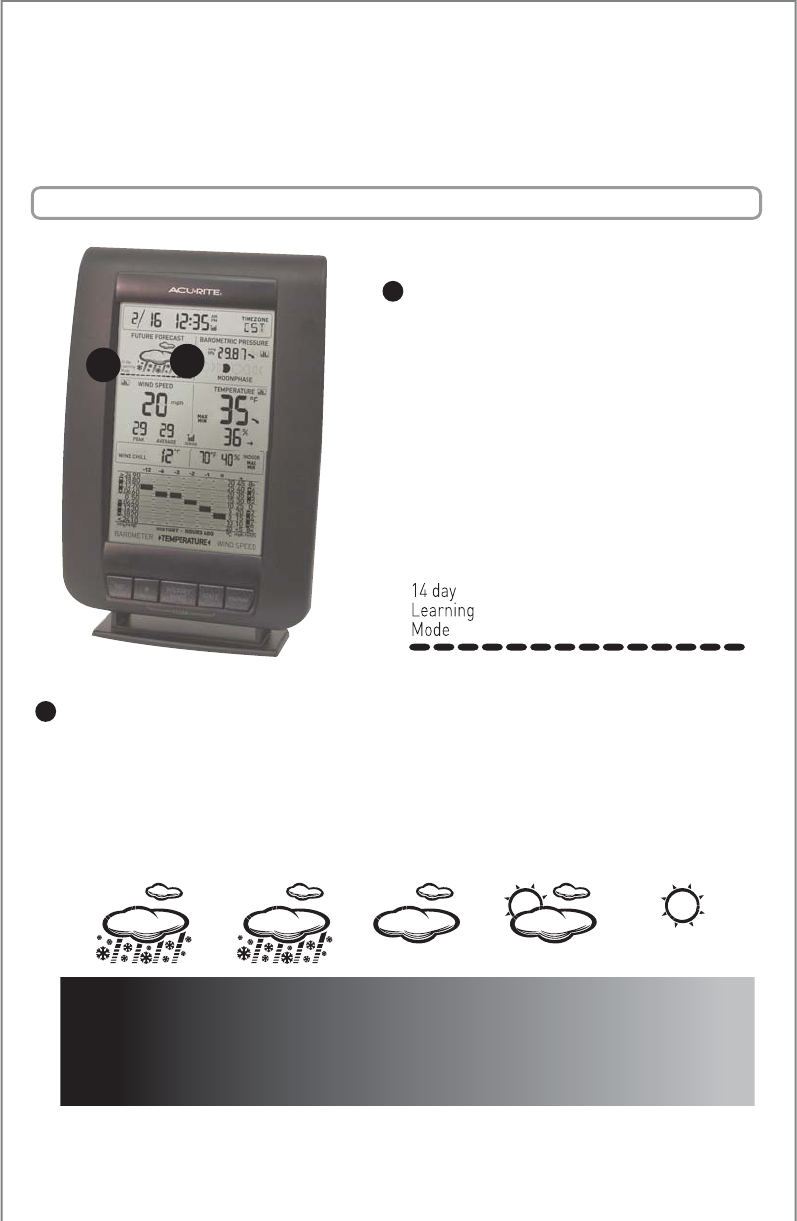
The main unit is capable of displaying some values in an alternate scale mode.
To switch between modes, press the “SCALE” button.
NOTE: The “WIND SPEED” history mode chart will not change to “kph” scale, it will
remain displaying “mph” data.
Main Unit : Scale Selection
The wireless sensor will soon send a signal to the main unit and the two units will be
synchronized. It may take a few minutes for synchronization to be complete. If both
or one of the units appear to be functioning improperly, refer to the troubleshooting
section in this manual.
Setup is Now Complete
After installing batteries, it is recommended that you set the clock and calendar
initially. After the atomic clock signal is acquired, which may take up to 24 hours, the
clock accuracy and daylight saving time changes will be automatically maintained.
To set the clock and other preferences, press AND HOLD the “SET” button for 5
seconds to enter into SET MODE. Once in set mode, the preference you are currently
setting will blink on the display.
To adjust the currently selected (ashing) preference item, press the “+” button (press
and HOLD to fast adjust).
To save your adjustments, press the “SET” button again to move on to adjusting the
next preference. The preference set order is as follows:
TIME ZONE (PST MST CST EST)
DST (Daylight Saving Time ON OR OFF)
CLOCK HOUR
CLOCK MINUTE
YEAR
CALENDAR MONTH
CALENDAR YEAR
You will automatically exit SET MODE if no buttons are depressed for 30 seconds. You
may enter basic setup mode again at any time by pressing AND HOLDING the “SET”
button.
Main Unit : Basic Setup
- 7 -- 6 -
SCALE MODE 1 - U.S. Standard
Temperature - ºF (fahrenheit)
Barometric Pressure- inHg (inches of mercury)
Wind Speed/Peak/Average- mph (miles per hour)
SCALE MODE 2 - Imperial Standard
Temperature - ºC (Celsius)
Barometric Pressure- hPa (Hectopascal)
Wind Speed/Peak/Average- kph (kilometers per hour)
SECTION 3 • OPERATION
B
14 Day Learning Mode
This weather station has a patented
“fourteen day learning mode” calibration
process. During this learning mode the
weather station will make altitude
calculations that may aect the accuracy
of the forecast. Once the 14 day learning
mode process is complete, the learning
mode icon will disappear and the
weather forecast should be ready for
superior operation.
A
AB
Future Forecast Icon
The future forecast feature automatically gives you the predicted weather forecast
icon for the next 12 to 24 hours based on an advanced algorithm that analyzes
barometric pressure changes and temperature. This weather forecaster will provide
the most accurate forecast that a single station instrument can provide.
HEAVY STORM
heavy stormy
weather
conditions are
forecasted
when ashing
stormy conditions
are forecasted
next 12-24 hours
mostly cloudy
conditions
are forecasted
next 12-24 hours
partly cloudy
conditions
are forecasted
next 12-24 hours
mostly sunny
conditions
are forecasted
next 12-24 hours
STORMY MOSTLY CLOUDY PARTLY CLOUDY MOSTLY SUNNY
rain or snow rain or snow
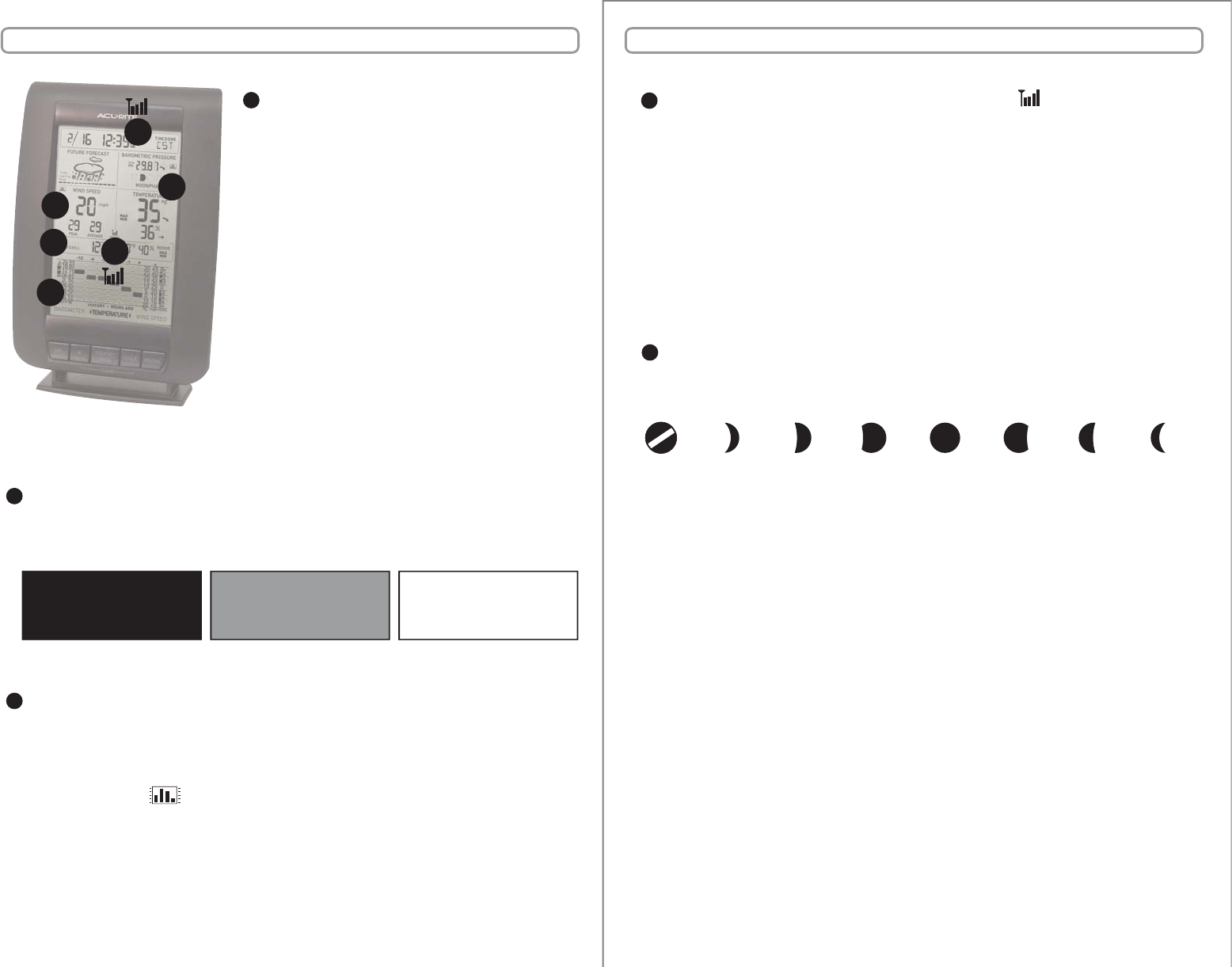
- 9 -- 8 -
SECTION 3 • OPERATION SECTION 3 • OPERATION
History Mode Graphing
This weather station features a selectable history mode which will graph and
display the changes for the last 12 hours (-12,-6,-3,-2,-1, 0). There are 3 selectable
weather categories; Barometer (barometric pressure), Temperature or Wind
Speed. Press the “HISTORY MODE” button to alternate through the 3 options. Note
the graphing icon “ “ next to the currently selected data window.
BAROMETER: hourly reading on the hour.
TEMPERATURE: hourly (outdoor) temperature reading on the hour.
WIND SPEED: hourly wind speed AVERAGE reading.
E
Wireless Signal Reception Icons
The main unit has a signal reception icon in the outdoor wind speed/ temperature
display area. If most or all four of the bars are present, wireless reception is good
and no action is required. If there are a low number of “bars” present, you may
experience wind speed/temperature inaccuracy. In either case, you may need to
relocate the main unit or the wireless sensor.
The main unit has a signal reception icon near the atomic clock display. If the atomic
clock signal bars are low, the clock may be inaccurate or may not automatically
adjust for daylight saving time (DST). Refer to the troubleshooting section in this
manual if you are having reception issues.
F
Seasonal Window (wind chill/dew point/heat index)
This weather station features a “Seasonal” window which will automatically display
the wind chill, the dew point or the heat index information when it is relevant.
D
Moonphase
This weather station features a moonphase window which will automatically display
the current moonphase, provided the calendar is set properly.
G
Wind Speed Data Window
This weather station features an advanced
wind speed data window that provides the
wind speed, the peak value and the average
value.
WIND SPEED: most current wind speed reading,
this value is updated every 18 seconds.
PEAK: the highest wind speed reading
recorded in the last hour.
AVERAGE: the combined averaged wind speed
readings from the last 2 minutes.
NOTE: The wireless sensor must be placed
outdoors to observe outdoor wind speed.
C
C
D
E
F
F
G
WIND CHILL DEW POINT HEAT INDEX
less than 40ºF (4ºC) between 41ºF - 79ºF above 80ºF (27ºC)
(5ºC - 26ºC)
This wireless weather station features a MIN/MAX memory feature which records the
MINIMUM and MAXIMUM indoor & outdoor temperature and humidity readings.
To view the MINIMUM temperature and humidity readings, press and release the
“MIN/MAX” button. Note the “MIN” icon on the display.
To clear the MIN recorded values, press and hold the “+” and “SCALE” buttons
simultaneously for 3 seconds while in the MIN view mode. Dashes will display in the
display to conrm you have cleared the MIN values for outdoor temperature and
indoor temperature/humidity.
To view the MAXIMUM temperature and humidity readings, press and release the
“MIN/MAX” button. Note the “MAX” icon on the display.
To clear the MAX recorded values, press and hold the “+” and “SCALE” buttons
simultaneously for 3 seconds while in the MAX view mode. Dashes will display in the
display to conrm you have cleared the MAX values for outdoor temperature and
indoor temperature/humidity.
Main Unit : MIN/MAX Memory
NEW WAXING
CRESCENT
WANING
CRESCENT
WAXING
GIBBOUS
WANING
GIBBOUS
1ST
QUARTER
3RD
QUARTER
FULL
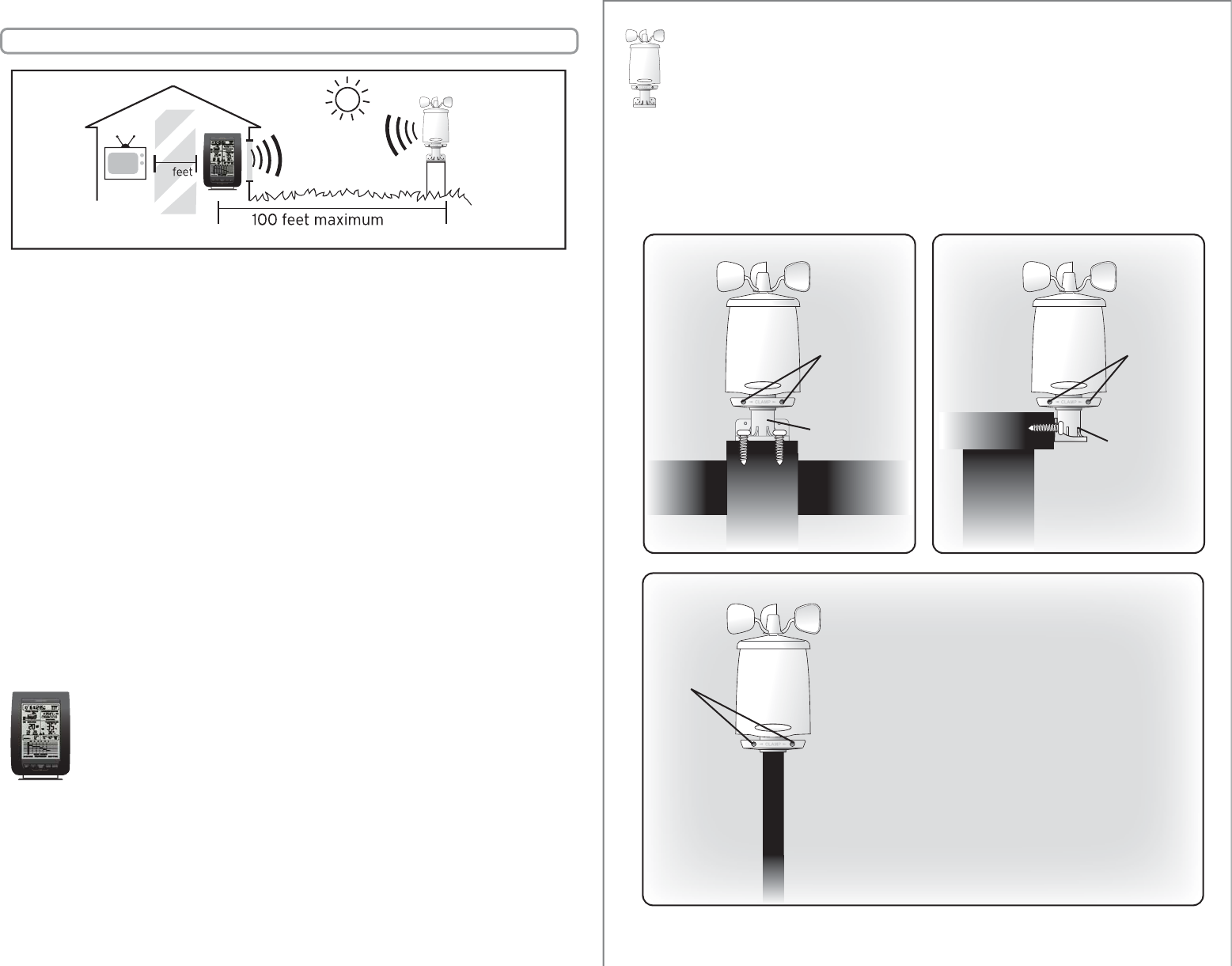
Place the main unit in a dry area free of dirt and dust. To help ensure an
accurate indoor temperature measurement, be sure to place the main
unit out of direct sunlight, and away from any heat sources or vents in
your home. For the best atomic clock signal reception, place the main
unit with the back side facing the state of Colorado.
There are 2 placement options for the main unit. You may hang the main
unit on a wall using the integrated hang hole. Alternatively, you may
place the main unit on a table top or other at surface using the included
detachable table top display stand.
Placement of Main Unit
The wireless sensor MUST BE MOUNTED OUTDOORS to observe outdoor
temperature/humidity/wind speed and relay the information to the main unit
display. The wireless sensor must be placed less than 100 feet (30 m) from the
main unit.
The wireless sensor must be mounted securely. It is advised that the wireless
sensor be mounted well above and away from all obstructions to report the wind
speed accurately. There are three main mounting options to consider:
Placement of Sensor
SECTION 4 • PLACEMENT
Now that setup is complete and you understand how to operate the weather station,
you must choose a location to place the wireless sensor and the main unit. The
wireless sensor MUST be placed less than 100 feet (30 meters) away from the main
unit.
This wireless weather station uses radio frequency for communication, which is
susceptible to interference from other electronic devices and large metallic items or
thick walls. Always place both units at least 3 feet (.91 m) away from appliances ( TV,
microwave, radios, etc. ) or objects that may interfere with the wireless
communication ( large metal surfaces, thick stone walls, etc. ).
Please USE EXTREME CARE when handling the wireless sensor and the main unit. The
wireless sensor contains sensitive electronic components and a balanced
anemometer (for wind speed measurement). Care must be taken during setup and
when considering placement to make certain the unit is not dropped or struck with
any falling debris from trees or structures.
USE CAUTION when utilizing tools or equipment for mounting the wireless sensor.
Enlist the help of another individual when necessary.
TV 3
(30 meters)
(.91 m)
MOUNT IN AN
OPEN AREA FOR
UN-OBSTRUCTED
WIND SPEED
MEASUREMENT
- 11 -- 10 -
TIGHTEN
CLAMP
SCREWS!
TIGHTEN
CLAMP
SCREWS!
TIGHTEN
CLAMP
SCREWS!
“FENCEPOST” OR SIMILAR MOUNTING “RAILING” OR SIMILAR MOUNTING
“POLE” OR SIMILAR MOUNTING
INCLUDED
MOUNTING
BRACKET
INCLUDED
MOUNTING
BRACKET
NOT USED
(POLE NOT
INCLUDED)
INCLUDED
MOUNTING
BRACKET
SCREWS
SCREWS
Mount the sensor onto a 3/4” schedule 40 (25.8 mm
O.D.) pipe (not included). PVC plastic pipe is
recommended over a metallic pipe due to lower
risk of lightening strikes.
Insert the pole completely into the bottom of the
wireless sensor. Tighten the “CLAMP” screws
securely to make certain the wireless sensor will
not fall or slide o of the pole in high winds.
Use caution when installing sensor or erecting the
pole. Do not install during electrical storms. Do not
place pole or sensor near electrical transmission
lines or electrical equipment.
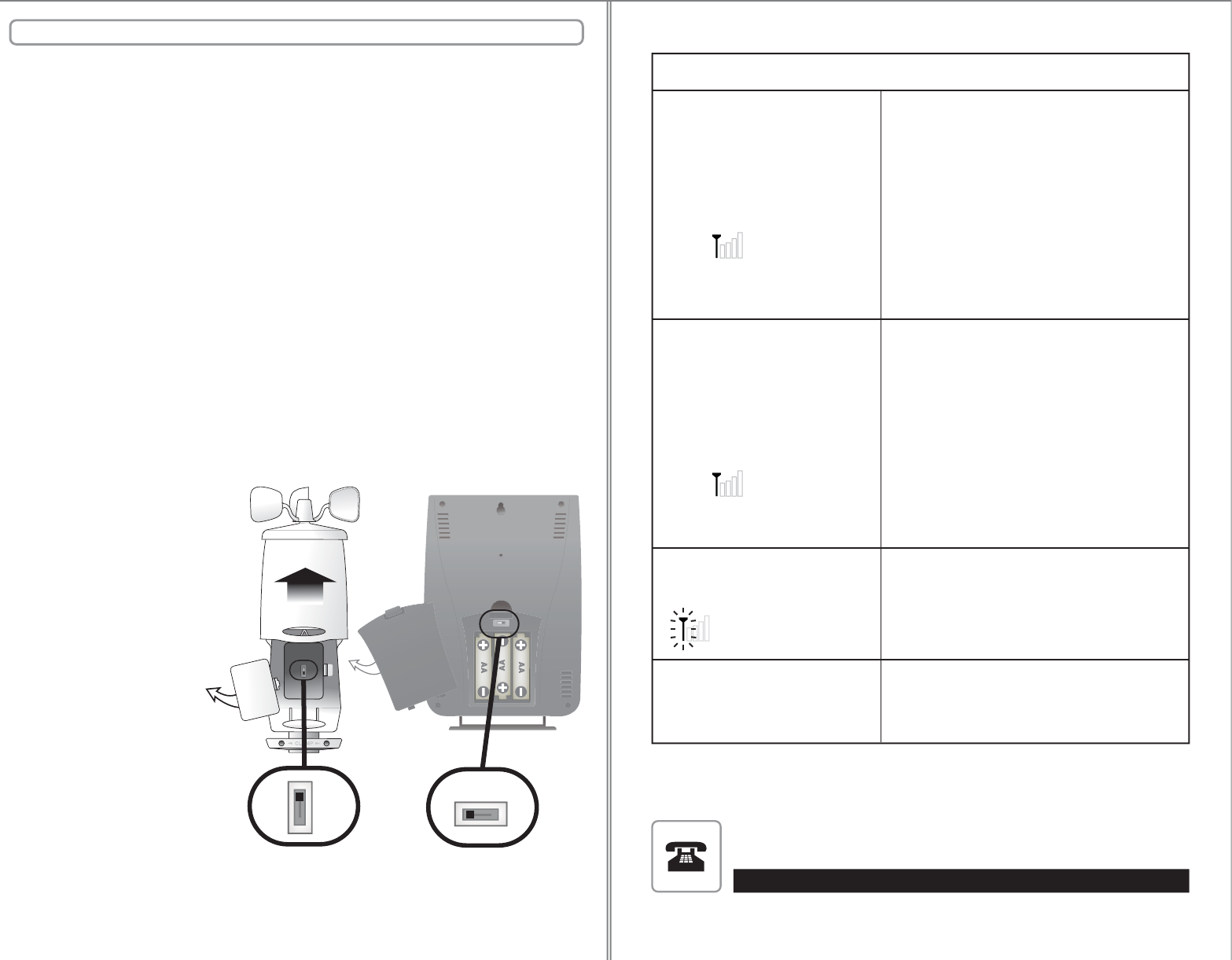
This wireless thermometer
uses long range 433mhz
radio frequency for
communication.
In the event that you have
reception problems due to
interference, both the main
unit and the wireless sensor
have a selectable wireless ID.
The ID switches are located
within the battery
compartments of the main
unit and the wireless sensor.
You may choose A, B or C; but
both the main unit and the
wireless sensor ID's must match
for successful synchroniza-
tion.
Set Wireless ID
A B C
Both wireless ID’s
must match
Troubleshooting
Measurement Ranges
Temperature
Main Unit: 32ºF to 122ºF / 0ºC to 50ºC
Wireless Sensor: -40ºF to 158ºF / -40ºC to 70ºC
Humidity
Main Unit: 16% to 98% Relative Humidity
Wireless Sensor: 1% to 99% Relative Humidity
Wind Speed
Wireless Sensor: 0 to 100 m.p.h. / 0 to 161 kph
Specications
Power Requirements
Main Unit: 3 x “AA” alkaline or lithium batteries
Wireless Sensor: 4 x “AA” alkaline or lithium batteries
Wireless Communication 433 MHz Radio Frequency-Transmission every 18 seconds
SECTION 5 • PRODUCT SPECIFICATIONS
- 13 -- 12 -
Problem
Bad
Wireless Sensor
Reception
Main Unit
Display Not Working
Make certain that the batteries are installed
correctly and that they are contacting the
terminals. Make certain all contacts are clean.
The batteries may need replacing.
No Wireless Sensor Data
(no communication)
If wireless reception is bad (no bars), see
“Bad Reception” section above. The wireless
ID setting on each unit must match for all
units to communicate properly. See “Set
Wireless ID” on the previous page.
Possible Solution
no bars
no bars
no bars and ashing
antenna icon
Bad
Atomic Clock
Reception
Atomic Clock
Frequency: WWVB 60Khz
Synchronizes Daily
Please DO NOT return product to the retail store.
For technical assistance and product return information, please call Customer
Care: 877-221-1252 Mon. - Fri. 8:00 A.M. to 4:45 P.M. (CST)
www.chaneyinstrument.com
Relocate the main unit and/or the wireless
sensor. Both units must be within 100 feet (30
m) from each other. Make sure both units are
placed at least 3 feet (.91 m) from other
electronic appliances and devices that may
interfere with the wireless communication (such
as TV’s, microwaves, computers etc). NOTE: It
may take up to 20 minutes for the main unit to
re-synchronize with the sensor when batteries
are replaced. Use lithium batteries in sensor
when temperature is below -4ºF (-20ºC).
A
B
C
Rotate the wireless sensor 90º on its mounting
point. Make certain there are no large stone or
metallic surfaces disrupting the signal line-of-
sight to the state of Colorado. Make sure the
main unit and wireless sensor are placed at least
3 feet (.91 m) from other electronic appliances
and devices that may interfere with the wireless
communication (such as TV’s, microwaves,
computers etc). Large metallic surfaces will
interfere with the atomic clock signal.